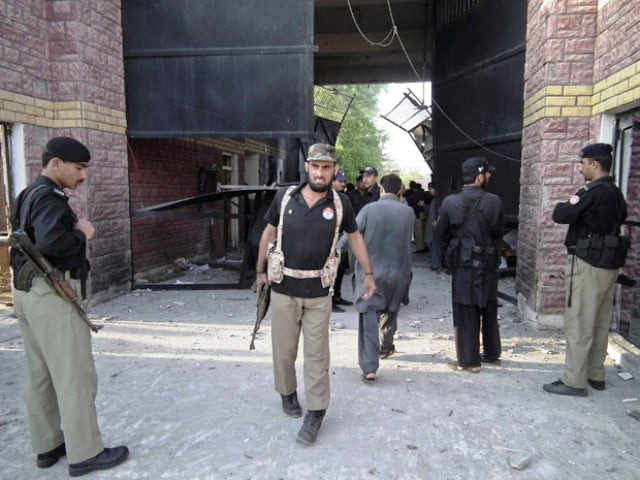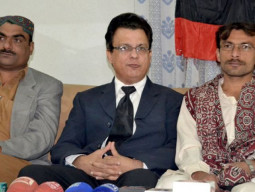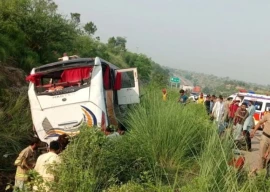
The Taliban’s invasion on the fortified Dera Ismail Khan jail on July 29 once again exposed the ‘protocol-oriented’ conventional ‘peace-time’ security that has consistently failed while facing the militants’ tactics of fourth generation warfare.
The security bubble raised around the 150-year-old jail was more or less as archaic as its construction. The security tiers were based on assumptions that reinforcements would arrive from outside while the police and jail officials would fight from inside. On the other hand, the militants used sophisticated tactics that have been previously battle-tested in other war theatres (Iraq, Afghanistan, etc) and then successfully tailored to the home terrain.
The militants carried a frontal attack on the jail by first parking their 13 vehicles in the town hall, located in the north of the jail. This provided a safe haven for their inventory, which could have been targeted if they were parked in front of the gate. The advance party of 18 persons arrived in police uniform. This was an excellent camouflage that made their mobility in the city as well as access to the jail easier.

The outer pickets and peripheral gate were targeted by RPGs. Even the Wah-made armoured personnel carrier could not sustain two RPGs and its destruction led to ‘life-saving’ escape of the remaining prison security.
While the ‘attacking party’ was busy in releasing the inmates, two ‘engagement parties’ remained entrenched on the eastern and western flanks of the jail and established ambush points to neutralise any outside support.
The militants disconnected power supply to the prison so that the response of the law enforcement agencies was delayed and confused. On the other hand, they were equipped with night-vision goggles that made their navigation comfortable.
The attackers resorted to excessive use of explosives. Three types of improvised explosive devices were used: the 30kg heavy time devices, remote-controlled IEDs and miniature IEDs. The offices of jail officials were rigged with the 30kg heavy time devices, which destroyed their records. The remote-controlled IEDs were used as mines on the roads that lead to the jail. When the LEAs responded, the remote-controlled IEDs deterred their advance. Detonation of around 70 IEDs had the ‘shock and awe’ effect. One official described it as ‘qayamat e sughra’. The miniature IEDs were used to open the cells and barracks inside the jail.
They were carrying wireless communication system similar to the LEAs. When the chief of police ordered his officers on wireless to reach various deployment points, the militants retorted on the same frequency and channel that the police was using. They ‘challenged’ them and ‘welcomed’ them to the jail premises where they were waiting for their ambush.

They also resorted to psy-ops and diversionary tactics in this process. After completing their mission at the jail, they communicated on wireless that their next destination was the military garrison. This hindered the military units to come to the support of the jail security as they were anticipating an imminent attack on the garrison itself.
The composite attacking group included suicide bombers. However, none of them was used because of the unexpected ‘walk-over’ from the security officials. The attackers spoke both Pashto and Seraiki which made their blending in the local milieu easier. This also shows that militants from Waziristan as well as urban militants from Dera Ismail Khan participated in this invasion. They had complete intelligence of the barracks, up to the mark cartography and information about inmates belonging to the Shia sect. Not surprisingly, they fished out four Shia convicts in the ensuing chaos not by chance. Three of them, Jumma of Multan, Sajid of Kohat and Aslam of Dera were killed by shooting at them. Akhtar Abbas, who was reportedly involved in the killing of Sipah-e-Sahaba cadres, was beheaded. This also signifies the sectarian streaks which the militants exhibit frequently. Among the 11 high-profile released terrorists from barrack number 12, Ilyas and Waleed, were convicted for more than 1,600 and 1,500 years respectively.
Other important militants from Quetta and Parachinar included Abdullah, Bilal, Ghulam Rasul, Abdul Rashid, Mamoor, Abdul Rahman and Jamaluddin. Abdul Hakim, another important inmate, carried a head money of $500,000 (according to militants). Generally, the militants attack in pre-dawn hours. However, this attack started at around 11:10pm and completed at around 2:20am. The timing of the invasion was chosen after ‘taraweeh’ since most of the people would wake up at around 3:00am for sehri.
The attack was masterminded by Adnan Rashid, a resident of Swabi who escaped earlier from Bannu Jail. He reportedly code-named it ‘marg-e-najat’ and invested around Rs10 million on it. He has emerged as the new rock star of militants who recently wrote a letter to Malala Yousafzai. He himself is a Yousafzai.
Since, this is not the militants’ last attack; there are some lessons for the government (s) too. First, if the government wants dialogue with the militants, then security people will not be ready to increase the population of the graveyard. Sacrifice and morale has limits when the governments are adamant on appeasement.
Second, the invasion must provide ‘high-caloric’ food for thought to the security establishment. What if a similar invasion is carried out on the nuclear infrastructure or any airport? Are we ready for the political fallout of such attacks? Thirdly, fourth generation warfare cannot be won by suspension of SHOs and ‘high-powered’ non-consequential inquiries. It requires more grey matter than that.
Fourth, what happens in extra-territorial theatres of Iraq and Afghanistan are ultimately practiced in Pakistan. There are common denominators in the jailbreaks of Abu Ghraib, Kandahar and Dera Ismail Khan. Terrorism has become a ‘skills-driven’ and ‘knowledge-intensive’ industry. Moreover, ‘good practices’ are shared among terrorist organizations like corporate sector.
Almost 100 security officials saved their skin from the militants’ onslaught; the only person now in the custody of the ‘torch-bearers’ of Islam is a lady constable Ghulab Bibi of Peshawar.
(The writer is a police officer with extensive experience in security and counter-terrorism. He was also the lead investigator in the Mumbai attacks, Benazir Bhutto murder case and Marriot attack)
Published in The Express Tribune, August 6th, 2013.


















COMMENTS
Comments are moderated and generally will be posted if they are on-topic and not abusive.
For more information, please see our Comments FAQ